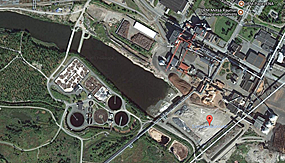
Sampaanalanlahti port area © Ramboll Oy
Ramboll is utilizing waste from industrial areas, as well as contaminated sediments in filling the Sampaanalanlahti port area. The aim of the project is to conserve virgin rock material, reduce air emissions and achieve cost savings in comparison to traditional earthwork.
The additional industrial waste mass is not only a viable filling material for the port, which is being converted into an industrial area, but it can also be used to significantly impact the quality of the processed masses. By means of a variety of binding agents, durable field structures can be created. The filling and covering layers added on top of mass stabilization utilize industrial by-products and waste.
New materials combinations from industrial waste materials
The project will test the possibilities of using a variety of industrial by-products and waste in the Sampaanalanlahti structures. The materials to be tested include various types of ash, plaster, green liquor sediment, kaolin clay, lime sludge and waste lime. The utilization of these materials will be tested in connection to various soft-soil materials, such as clay, surplus soil and dredged sediments. The various processing opportunities of the materials will also be explored.
The project will test a variety of mass stabilization applications, body material improvement opportunities, and filling and covering structure solutions. Simplified life cycle analyses and life cycle cost calculations will be prepared on the selected structures to compare the project with a more traditional structural solution.
Sediments for utilization
The dredged sediments from the Rauma route have been partially contaminated with tributyltin (TBT), hydrocarbons (particularly PCB) and metals, including notably high concentrations of copper. Sediments may not be dumped in sea areas, but they can be used in the bottom structures of the fields to be prepared in the Sampaanalanlahti area by mixing them with the material requiring stabilization at the bottom of the bay.
The project is part of a larger 10-hectare whole, of which this subproject will cover some 1.5 hectares. The project will be conducted within the framework of the effective environmental permit.
Schedule
More information
- Technical matters: Harri Jyrävä, Environmental Geotechnics R&D, Ramboll, tel. +358 (0)400 732 593, firstname.lastname@ramboll.fi
- Project Manager: Tuomas Suikkanen, Environmental Geotechnics R&D, Ramboll, tel. +358 (0)40 145 7379, firstname.lastname@ramboll.fi